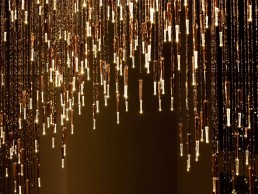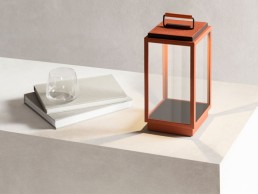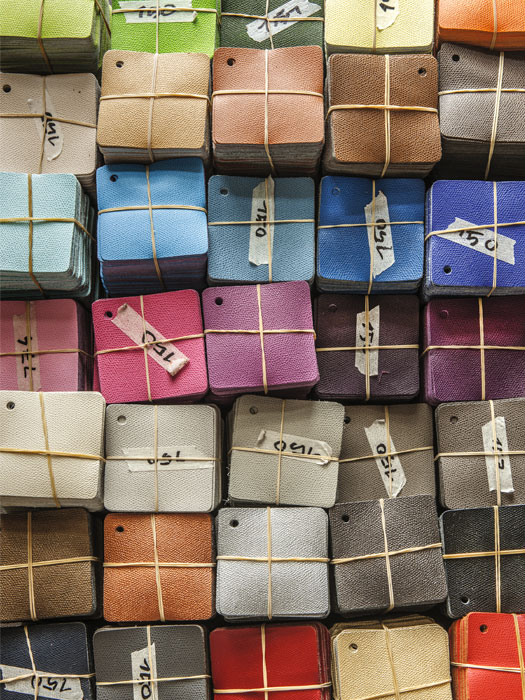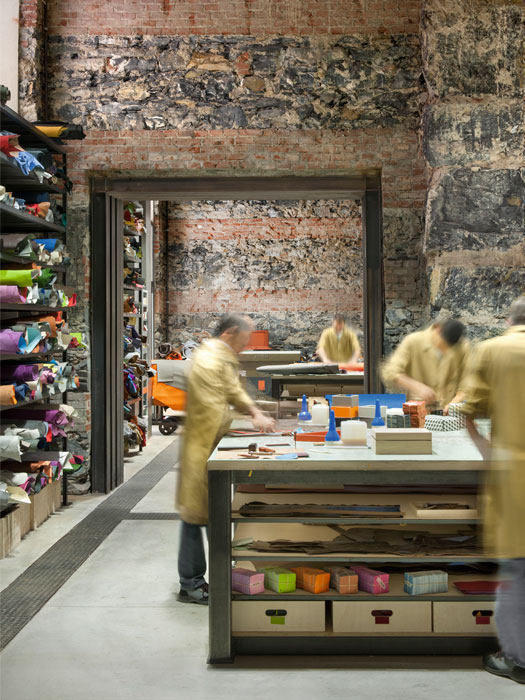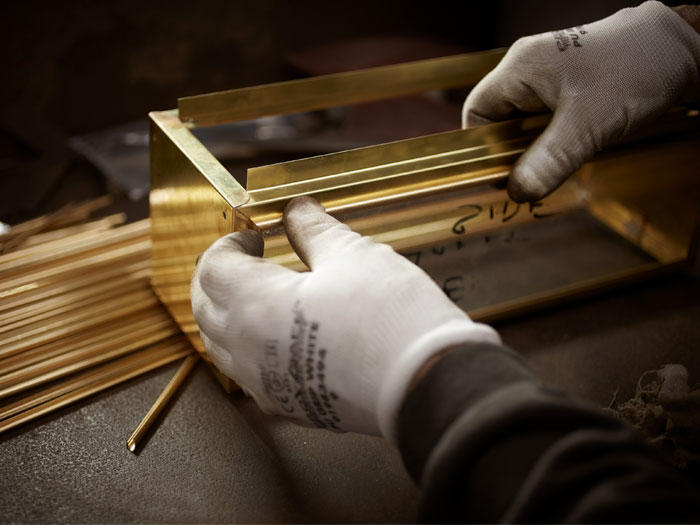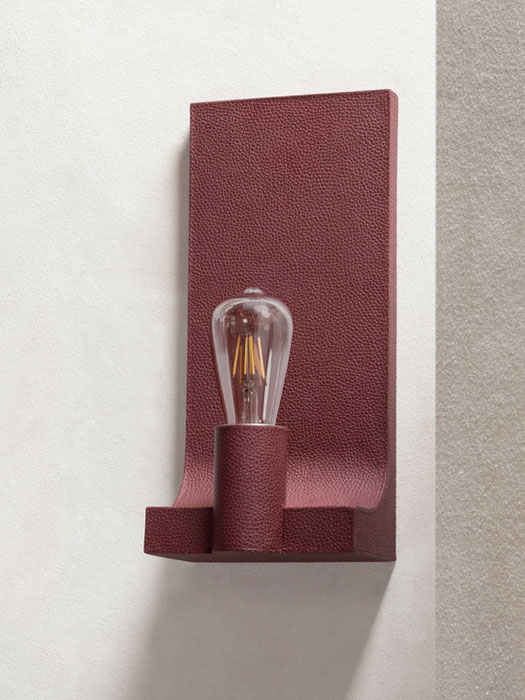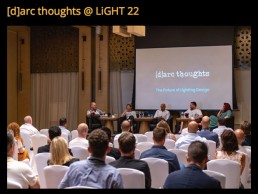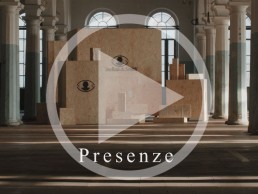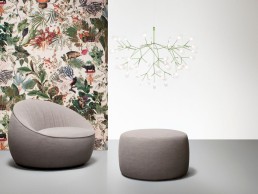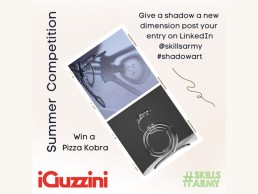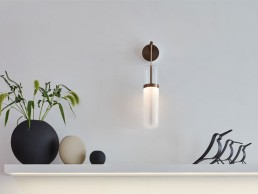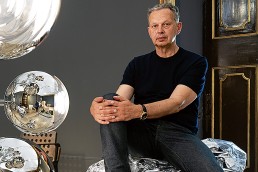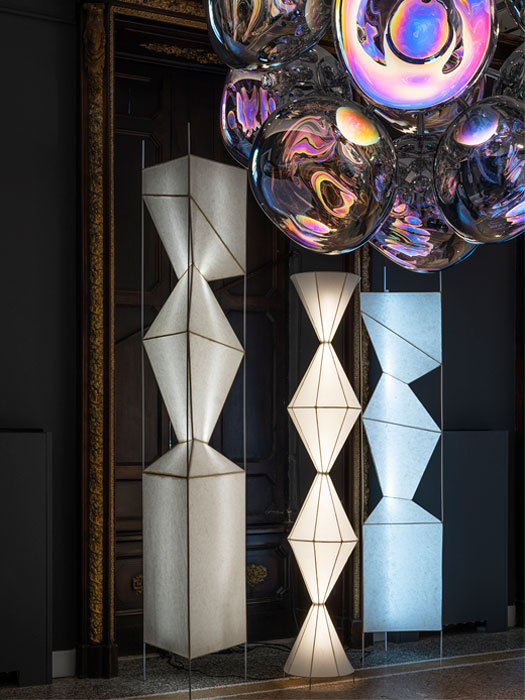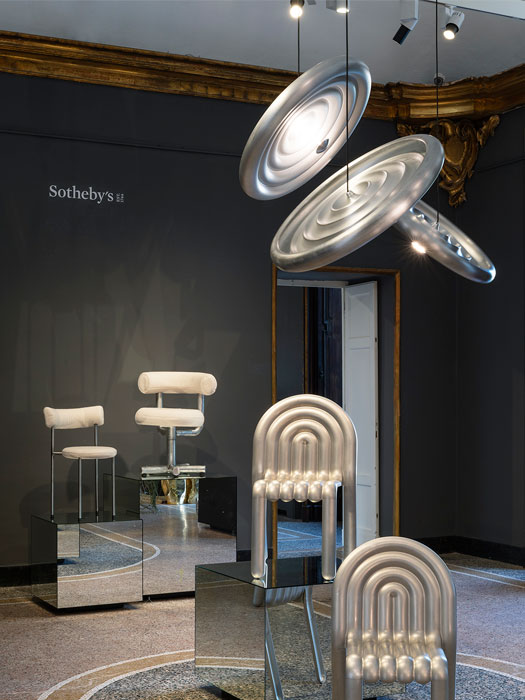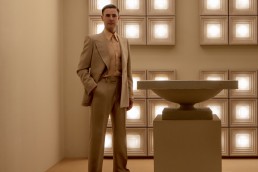Dusk - ByBeau
ByBeau's newest bespoke creation Dusk has been a work in progress as the team waited for technology to catch up to fulfil the aesthetic desires. The stunning installation transforms any space from dawn to dusk.
Dusk, created by studio ByBeau, is inspired by the time of day when shadows grow and light becomes copper-gold; dusk.
Each copper body of Dusks’ stalactites forms the base to apply precious metals like gold, silver or a myriad of non-precious finishes. This flexibility allows full customisation to create a "personalised sunset".
Beau McClellan, Creative Director, says: "The ideology behind Dusk was a form that would work equally well within both classical and contemporary environments. Dusk soon became an exploration in temporality; waiting for technology to catch up with a design intended to prevent time from doing the same to its aesthetic."
Hand-ground crystal tips are seamlessly attached to each copper finger, with each angle precisely aligned. Great care was taken to ensure that no trace of manufacturing threatened the organic feel of Dusk.
The angles refract and reflect light throughout the chandelier, bouncing it from element to element. "This produces a sensory experience reactive to the configuration and scale of the whole piece. Flickering and glistening; alive with the arcs and patterns created," adds McClellan.
Each finger houses a powerful LED - of specific colour temperature - that is small enough to fit comfortably within. "The breakthrough unit used in Dusk combines extraordinary power with compact size. A challenge to the clean lines of the design was posed by the more powerful LED requiring the incorporation of a far more effective heat sink to dissipate the temperature.
-
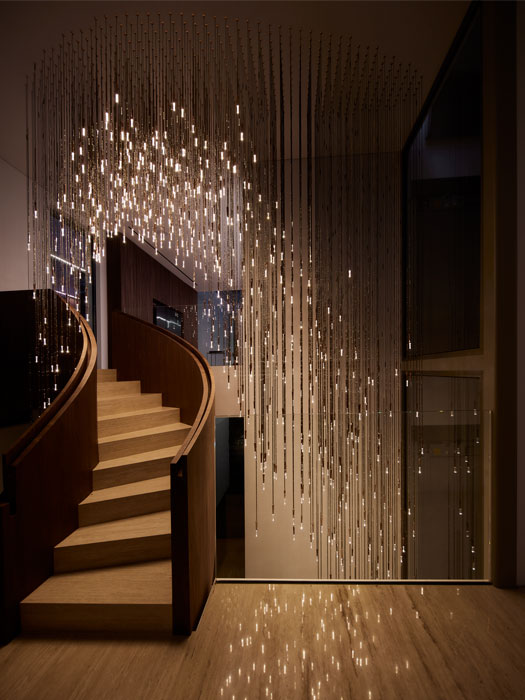
All images: Vasco Celio/stills
-
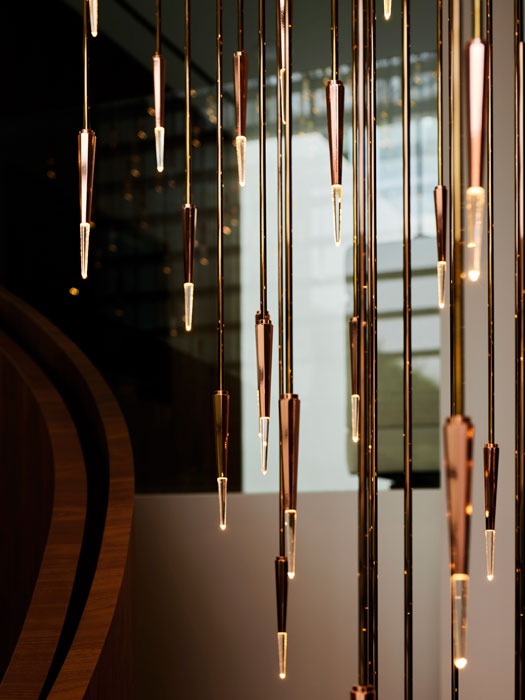
"Dusk aptly transitions between day and night without imposing the ambience of either. Twilight has an illusionary nature with the sun neither above the horizon nor below it; a balance of day and night - there cannot be one without the other, yet they cannot exist at the same time. Our Dusk represents dualism; a bond of form and function, of classical and contemporary…of night and day.
"Dusk is a piece that showcases many of the philosophies that define the work of ByBeau. The time it took to produce is a testament to our team’s dedication to their art. As artists we seek to challenge ourselves; to produce the creative, rather than the easy," McClellan concludes.
Tekna x GioBagnara
Working together with Italian leather brand GioBagnara, Tekna has produced a new collection consisting of existing fixtures but finished in sleek leather, available in numerous colours.
Tekna’s recently released collection was formed in collaboration with Italian leather brand GioBagnara. Bringing together leather and lighting is a new approach for the Belgium-based brand and one that brings a less-common material to the lighting specification market. The new collection is comprised of the Blakes table lamp, Marquesse floor lamp, and Walcott and Walcott Twin wall lamps.
“The Tekna x GioBagnara collection aims to create pieces able to generate unique atmospheres and enhance spaces, giving birth to a union where traditional Italian and Belgian lifestyles meet,” says Tekna. “[We] have loved unique and durable materials including brass and bronze since day one. Leather is a great addition to this, as it is unique and in this way distinguishable.
“We have chosen to work with leather because, in addition to the qualitative aspect, it also gives an extra structure to the finish. Leather can do a lot with your interior. It all depends on the way you use it as to what kind of leather you use and with which colours you combine.
“Leather lends itself very well to the upholstery of our appliances as they contain a lot of details including ledges and glasswork. All these details need to be finished to a high standard, which we thought other materials, such as wood, would not allow.”
The collaboration between Tekna and GioBagnara was born from Tekna’s long-standing admiration for the leather brand and its craftsmanship. Since approaching GioBagnara a few years ago, the teams worked together to produce this new collection after numerous design meetings and product prototypes within four months.
“The concept is simple but works tremendously. We cover existing lighting fixtures with leather, which creates a totally new approach to lighting. By working with leather the light produces a very different glow,” continues Tekna.
“For this collection, we chose to transform some of our bestsellers into works of art in leather. And this combination resulted in great success. This is found in the details, and the fine craftsmanship, the hand-applied leather and stitching details, which in all have created an enhanced decorative element of this collection.”
One of the challenges the teams found throughout the process of working with a new material was ensuring that the aesthetics and functionality were not compromised. The hand-crafted approach meant they could keep an eye on the details and finishes, and make tweaks along the way that supported each individual fixture.
Wanting to maximise the customisable features of these lamps, it is possible to choose from more than 370 leather finishes and more than 100 colour swatches and stitch colours. This enables the user to select a unique combination for their product to suit their residential or hospitality space. “This way you can choose the eye-catcher for your home or opt for a more simple and ton sur ton piece,” says Tekna.
“We want Tekna to be the Louis Vuitton of the lighting world. And just like buying your favourite handbag, we want to emulate that special feeling. This collection complements it perfectly,” it concludes.
Entries open for SLL Young Lighter 2022

(UK) – The Society of Light and Lighting (SLL) has announced that entries for the SLL Young Lighter 2022 are now open. Aimed at people in the early stages of their lighting career, the competition is open to anyone under the age of 30 with an interest in light and lighting.
Entries can be based on any light-related topic, and the winner will receive £1,000 in prize money, along with the prestigious title of SLL Young Lighter 2022.
The competition is designed to provide people with a platform to share their lighting ideas – this could be a piece of research, a lighting concept or design, new technology or product, or even a proposal for a new lighting metric or design methodology.
Previous winners include Maria Englezou, whose winning paper questioned current approaches to the design of lighting for healthcare facilities rooms; Aluwaine Manyonga, who proposed an off-grid solar lighting system to help provide improved access to education in Africa; and Anna Wawrzyniak, who proposed a light boosting system to support the circadian rhythms of commuters using underground transportation for their commute to and from work.
The competition is open to entrants from all over the world and is broken into three stages. Entry Stage One calls for six introductory Powerpoint slides outlining the entry. These could include images, illustrations, graphics, animations, text, voice etc; at Stage Two, the SLL will ask entrants to elaborate with a short presentation to expand on their initial ideas. This can be in whichever format they feel illustrates the entry best; for Stage Three, finalists will be selected and invited to deliver a 15-minute presentation in front of an online audience.
Entries are open until 25 August. More information can be found on the SLL website here. Or you can email sll@cibse.org for further details.
LiGHT 22 announces talks programme

(UK) - Alongside LiGHT 22's exhibition, the team at [d]arc media bring you its latest instalment of [d]arc thoughts.
In collaboration with Lutron, the two-day talks programme will feature insightful comments and discussions from designers working at some of the leading studios in the industry.
Confirmed topics include:
DAY ONE
- The Future of Materials
- Lighting Design as a Strategy for Inclusion
- Starting out in Design
- The Lifespan of a Project
DAY TWO
- Design for Wellness
- Specifying Bespoke Lighting
- The Weaponisation of Light
- Dark Skies
More topics and speakers are to be announced soon.
Catellani & Smith's 2022 collection
In 2004, colour was introduced into Catellani & Smith’s catalogue for the first time with its PostKrisi collection. It used colour as a message of rebirth and joy. Today, that colour returns in its 2022 collection, presented here in a film by Giorgio Oppici captured earlier this year.
Moooi - Heracleum
Moooi’s iconic Heracleum is now available in a brand-new colour: Green.
The Heracleum is a Moooi Original design with a strong presence in the collection since its first introduction in 2010. The lifestyle brand honours its Moooi Originals by further improving them with new technology added into Heracleum III and a new colourway. The updated design in a new colour highlights its floral inspiration.
Also, all designs in the Heracleum III family are now compatible with Moooi’s Wireless Wall Switch.
Skills Army launch photography competition
(Online) – Skills Army has launched a photography competition, inviting participants to tell a story through shadows.
The competition, open to all through LinkedIn, asks entrants to “give a shadow a new dimension”, and to celebrate the power of shadows.
To enter, participants just need to post their images to LinkedIn, tagging Skills Army and using the hashtags #shadowart and #skillsarmy.
The winning entry will win an iGuzzini Pizza Kobra light fitting, designed by Ron Arad.
Michael Grubb Studio promotes Daniela Rendon to Project Lighting Designer
(UK) – As part of its ongoing response to significant levels of rapid growth, Michael Grubb Studio has promoted Daniela Rendon to Project Lighting Designer.
Having worked for the studio since 2019, Rendon has demonstrated her commitment to the lighting design industry. Her skills and knowledge have undoubtedly contributed to the success of many of the company’s recent projects.
In her new role, Rendon will manage design projects at varying stages of completion, working with a senior team member to ensure deadlines are met. She will put her self-motivation, good initiative, and organisational skills to good use, as well as demonstrate her ability to liaise with suppliers, clients, and design teams.
Rendon will be able to draw on her vast experience of working on projects of varying scales, across multiple sectors. These include the award-winning Bath Abbey project, King’s Walk Shopping Centre in Gloucester, and Woolsery in Devon. She has also been an active participant in industry events such as the creation of a lighting installation at the [d]arc Awards 2019, as well as being crowned a Technical Award Winner at the 2021 SLL Ready Steady Light challenge.
Speaking of her new role, Rendon said: “I am very excited to start my new position. I truly appreciate the opportunity and look forward to continuing to grow, as well as contributing to the creative and talented team of Michael Grubb Studio. I feel extremely motivated and encouraged by the team support, which makes coming to work an absolute joy.”
Michael Grubb, Founder and Managing Director of Michael Grubb Studios, added: “Daniela has proven herself to be a committed team member, with excellent lighting design and project management skills. In her new role, she will be able to build on these, as well as taking a more prominent position with clients and other stakeholders.
“I’m extremely proud of Daniela and it has been wonderful to watch her grow and develop as part of the Michael Grubb Studio team.”
Empty State - Pill Wall Light
Complementing its portfolio of statement pendant lights, the Pill wall light is Empty State’s first foray into wall-mounted lights. An adaptation of the existing capsule-shaped design, the light offers a new perspective, whilst remaining beautifully designed with exquisite attention to detail.
Combining handblown coloured glass with sharp brass accents, Pill delivers modern elegance and luxury. With a modular design comprised of customisable glass colour, metal finishes and light configurations, each piece is made to order, exquisitely designed and made by hand in London.
With its striking design and compact size, Pill provides an eye-catching lighting solution, suitable for a variety of spaces throughout the home. Hanging from its elegant, circular mount, the light reflects a soft, illuminating glow off the wall, creating an inviting and intimate space. From adding a contemporary feel to a bathroom to lighting a dramatic staircase, the Pill wall light can be used in both traditional and modern decor whilst adding artistic flair to any space.
Available in five stunning finishes including black anodised, silver anodised, brushed brass, burnished brass and polished brass, Pill can be paired with a variety of coloured glass options ranging from a bold, bright blue and opal to smoked, green and soft, pale pink.
Providing well-appointed lighting solutions to design-orientated homes and interiors, Empty State draws inspiration from contemporary architectural styles and design icons through the ages, with each product made with ultimate precision to the finest detail.
Tom Dixon
Celebrating 20 years of design, Tom Dixon launched the exhibition Twenty at Palazzo Serbelloni, a neoclassical palace where Sotheby’s has its Milan galleries and offices. Visitors were invited to explore a curated selection of designs, with 20 unseen pieces on display.
darc’s editor Sarah Cullen caught up with Dixon during an exclusive press preview of the collection in Milan to discuss the brand’s 20th anniversary and the direction he is pushing it in moving forward.
“We had a plan. Though I don’t think I was projecting it 20 years forwards from when we started, the initial idea of having the eponymous label has worked out as we hoped, but we thought [the journey] would have been a bit easier. From the perspective of mimicking let’s say the fashion industry, in terms of how you set up a business using your own name, having your own distribution, and your own communication, I didn’t realise that it would end up like this.
“Lots of stuff has changed in the interim, right? But what I didn’t realise is how much more difficult it is to cover [as a product designer] all the different categories of the home, from a distribution and logistics perspective, and the way people buy,” Dixon explains.
Further likening the varied manufacturing approaches to that of the fashion industry, Dixon explains that if you have one manufacturing technique such as sewing, for example, this can be replicated at home in the UK or in a factory in Vietnam. However, when it comes to producing homeware, every packaging box is a different size and shape, which entails different import restrictions, etc. “It’s been more difficult than I thought to do a whole interior concept, but I think the vision, if you want to call it that, and how you take control over your own destiny as a product designer is reasonably accurate,” he adds. “We are still the only company of our size that does that.”
When asked whether there was a particular design Dixon had wished to have launched by this milestone, he comments: “You have these fantasies about what people will buy and, although you gain experience and get better at predicting that, the reality is the market dictates it. And, getting things at the right price and at the right quality is tricky, particularly if you don’t have your own factory.
“We’ve become better in lighting, which is from a pull in the market. I thought we’d probably be more reflective of how people furnish their spaces, in terms of proportionality. Our lighting business is 60% of what we do, which is not equivalent to the proportion [of lighting] you have in your home or in a restaurant. The marketplace decides roughly what people will buy from you. Different parts of the world, like Hong Kong, would be much more accessories focused, for instance, and for logistical reasons, again, getting your furniture out there means much longer lead times, along with things like anti-import duties or restrictions of what type of testing you need for California; it’s a different picture for different parts of the world.
“So, it’s harder for you to have mastery over the destiny of a selection than it is to have over what the initial concept was, which is to have at least a way of creating your own universe. This is something most product designers don’t have; they’ve got an aesthetic, but their output goes to lots of other brands to be marketed and sold.”
With regards to Brexit and how it’s impacted them as a UK-based brand, Dixon describes it as a “perfect storm”.
“Brexit, if you’re an import / export business, is an abject disaster. You’d have hoped there’d be some advantage, any advantage, that had been carefully constructed behind the scenes during the three years [the government] had to sort it out, i.e., better conditions for British manufacturing, new export markets, seamless borders. But there’s none of it. It’s just become more paperwork, more inefficiency, and more unknowns – it’s a shocking picture,” he says.
Turning the conversation to Twenty, Dixon explains that the various pieces chosen were selected because they helped with getting the brand to where it is today. “I mean, to be frank, given the state of Milan - we’re going to have a little Salone in September, actually we’re going to have it in April now, no we’re now going to have it in June… - We didn’t even know if we were going to do this show this year.
“We wanted to look at some of the things that got us to where we are now and see whether they could be refreshed and rejuvenated. There are some things more experimental, and some that were so good we didn’t show them because we didn’t want to share them before they were available for sale. I might be exaggerating, but there were a couple of things that came back [from production] that were so bad we couldn’t possibly show them. So, you must be pragmatic about it.
“I also quite like showing some things that are total failures. For me, the rubber S chair is a total failure, but it’s still an amusing narrative and it’s an experiment. I also didn’t want to just look backwards - pulling out some pieces I thought were interesting that we never produced, like the paper lanterns for instance, feel relevant now.
“There were lots of ideas that went through a funnel, and what comes out the other end, comes out the other end. Then, you have some things that get stuck in customs, and others that arrived yesterday, which I’d never seen, like the aluminium lamps for instance. They looked great in 3D render, but they could have been rubbish, or they could have never turned up. There’s been some good surprises and there’s been some appalling disasters, but that’s just Milan. That’s how it rolls.”
The Melt chandelier, one of Tom Dixon’s most popular items, was selected as part of the Twenty exhibition. Dixon wanted to draw attention to it but with minimal intervention. Thus, a simple dichroic filter was added, creating an interesting and different effect to the iconic light. “We’ve all seen dichroic effects - maybe on cheap novelty sunglasses in Camden Market, or on the surface of early Roman glass in the British Museum - but I know that it’s a finish that has always fascinated me. The emergence of Modern Dichroic thin film filters, which split white light into its component colours, is the work of the engine of extreme innovation, NASA. When we looked at updating Melt, our most successful light, rather than offering a new shape, a new size, or a new colour, we decided to instead filter the light with a dichroic filter. The effect of the coated component is to channel the light of our powerful LED driver into constituent parts of the spectrum, giving the already crazed internal reflection an additional chromatic boost and an unexpected space-age aesthetic to this otherworldly lamp.”
Looking to be more sustainable in future product designs, the studio has been experimenting with various materials such as cork, mycelium, and biorock. “It’s becoming increasingly urgent. I can’t just sit around and ignore it, and so we’re doing our best to find substitute materials,” says Dixon. “The miracle with 100% recycled is you can’t really tell the difference. We thought there would be a significant drop in clarity or a significant increase in bubbles and imperfections, but it almost feels glassier because it’s not completely pristine and virgin. The only problem being is plastic is roughly 60 - 70% more expensive, so we have to see whether the market is prepared to pay for sustainability. Everybody wants to do it, but the proof is in the pudding. And I think what’s been interesting, in terms of observing how it can work, is the LED revolution where there’s a mix in legislation, which mainly came from California. This affected how the American sales worked. You can’t ignore California and then, combined with huge, amazing research, engineering and manufacturing, and progress, have designers piling on board trying to make acceptable sustainable solutions for the customer. I think it takes all three; it takes government, innovation, and science, plus some design.
“So, the difficulty with sustainability is that you see there’s an interest. People love to touch it, they want to be part of it, but will they consume it? Particularly if everything is brown. Brown has its moments, but these things are subject to fashions. I think it’s important for us to show what we’re working on, and if there’s genuine enthusiasm, we can accelerate on those things rather than making a series of mess-ups. Also, it’s never black and white. Plastic versus glass in terms of energy consumption it isn’t an obvious equation.
“We have been challenging ourselves and our factories to reduce our impact on the environment, so the monumental vertical chandelier [Mirror Ball] will be the first to display one of our oldest designs in a 100% recycled polycarbonate. The change in optical quality is imperceptible and is a demonstration of the opportunities now available in a rapidly changing landscape to try harder to find more credible alternatives to virgin material.”
Along with many other studios, the last couple of years has been a difficult one for the brand. However, Dixon admits they’ve “not thrived, but more than survived”.
He continues: “We’ve been hugely impacted from a manufacturing perspective. And it isn’t so much just manufacturing, Brexit, increasing in container costs, and the rest of it, which is a universal issue, it’s also the fact that there haven’t been any trade fairs. That makes it really hard to launch new products. Ours is a physical business where people still need to see pieces in person. It’s useless to do it on zoom.”
Looking to the future and the new generations of designers coming into the industry, darc asked for Dixon’s advice on getting yourself out there: “I think they’re in such a better position than I ever was to get attention without having to invest loads in physical showrooms. I can remember having to pay for stamps to send an invitation to a party like this, whereas now you can just gather a flash crowd in an instant - you can address the world from your bedroom. You’ve never been in a better position to make yourself visible and to sell, whether that’s on Etsy or Instagram. You’re able to create a business and FedEx your product to people all over the world from your bedroom. That’s amazing! But the most important thing then is how do you stick out from the crowd? The market is so much more saturated, and so it becomes harder and harder to make that impact even though it’s easier at the same time. So, there’s a kind of catch-22. The important thing is really finding your uniqueness and having a different point of view. There is absolutely no point in trying to be like me, or like anybody else. If you’re at the beginning of your career, you’ve got to be yourself,” he concludes.
Olga Hanono
One of Lladró’s latest collections, Firefly, presents four new designs from its collaboration with Mexican-based interior designer Olga Hanono.
Firefly takes inspiration from the unique light produced by fireflies on warm nights. From floor lamps to wall lamps, pendants, and wireless table lamps, with autonomous lighting and a USB rechargeable system, the composition of colourful porcelain fragments and a lampshade of translucent porcelain or fabric evokes the bioluminescence of the firefly.
darc speaks with Hanono to find out more about her inspirations for the new light fixtures and her collaboration with the decorative porcelain brand. “For me, lighting is something magical. Through the use of lamps, we can transform spaces throughout the day. It is the lighting that makes a space intimate and welcoming, or enigmatic and special.
“I have been designing for over 21 years, and I love to create one-of-a-kind projects where most of the design objects are crafted for a specific space and client. That’s why, when it comes to furniture and lighting, I have created many pieces for private projects,” she says.
“This is my first time collaborating with an international porcelain brand for a lighting collection, where I felt a very interesting and similar creative process between us.
“Lladró is a legend; the brand is a luxury bespoke porcelain manufacturer of the highest quality standards, and that, for me, was a beautiful experience because we brought together our separate wealth of knowledge and contributed it towards a very innovative design. The collaboration was more than fruitful. It was key to evolve together and transform alongside one another,” she continues.
“My inspiration for the Firefly collection was to create a unique art-piece that achieves a timeless sense with its own colour palette and design. It has a very unusual combination and because of its original aesthetic it became a conversation-starter.
“The collection is handmade using porcelain; the richness of every piece creates a bold statement for the eye. The craftsmanship that relied upon the design is amazing.”
Speaking of the colour choices, Honono explains that she chose to create a mix of different metallic pieces alongside her signature colour, teal. In addition to the colour play, she also added a layer of complexity with the various textures.
Working on the products during the international pandemic brought with it some challenges, but overall meant the team became very good at communicating and connecting between Mexico and Spain. The overall design process took just over a year from concept sketches to the final production of the first pieces.
“One of the biggest challenges we faced was that we were unable to visit the production plant in person. We had to ship colour samples from Spain as part of the design process, but thanks to our professional teams we became closer and even more communicative than before,” Hanono explains.
“I love being a part of the new chapter of luxury brands, with my signature artistic approach and my passion for design. I believe that the world is a different place now where people want a real collaboration between different personalities that inspires with real talent and creativity.”
Lee Broom
To mark the brand’s 15th anniversary, Lee Broom presented Divine Inspiration, his first lighting release in four years, which displayed six new lighting collections.
The exhibition showcased a series of ethereal and dramatic rooms, each featuring a piece from the collection, that led visitors through a theatrical experience inspired by religious houses of worship. The delicately curated journey explored the typical relationship between light and holy places and evoked feelings of “stillness, reverence, and contemplation” for visitors as they passed through the multi-levelled gallery.
Taking inspiration from architecture, Broom particularly focused on the Brutalist aesthetic. This led him to explore places of worship across various time periods, looking at the design language associated with religious architecture, interiors, and artefacts. The Divine Inspiration takes aesthetic nods from the “pared-back silhouettes of Modernism and Brutalism architecture that surrounded Broom as he grew up”.
Interviewed by darc during Milan Design Week, Broom says of the exhibition: “I’m always looking at things from the past with my collections. I always like to look back before trying to look forward. Everything that you do has a reference point from somewhere. And I think part of the thing that makes my products modern yet classic at the same time, is that I do reference things,” he explains. “It gives you the notion that you’ve seen it before, but not quite in the same way. We’re not trying to reinvent the wheel; I’m just trying to make people look at things in a different way, and I think that’s very typical of this collection. With future collections, I’m sure that I will definitely tap into some sort of other art form, whether it be historical or not. I tend to be drawn particularly to periods such as Bauhaus and Art Deco, the Mid-Century movement and then late 1970s Italian furniture as well. Those are the kinds of things that are always in life, or have been over the past 10 years,” he says.
“I also think it’s kind of nostalgic in a way; I was born in the 70s, and I think looking back at how your parents grew up, or what you have around you when you were growing up influences you. I was always massively into design and furniture and lighting when I was young. I used to do lots of trips to London with my mum, we would go to these incredible modernist furniture stores. I didn’t know the designers at that point, but I was always a huge fan of post-modernism and post-modernist architecture, for instance. So, you can kind of see that in my work.
“I grew up in Birmingham, so there was a lot of brutalist architecture in that city. I personally loved it, but a lot of people didn’t and unfortunately some amazing pieces have been demolished, which is just absurd. I love the cleverness of those buildings, the geometry, and the clever use of architecture within the interiors as well - how seating areas or desk areas or communal areas are incorporated into the visible parts of the architecture.”
Collections introduced as part of the Divine Inspiration exhibition include Vesper, Pantheum, Altar, Hail, and Chant.
Following an overpowering yet alluring soundtrack of ethereal, choir music, the first room of the exhibition you enter holds Pantheum. Inspired by the “distinctive coffered concrete ceiling of Rome’s ancient temple, The Pantheon, as well as the clean lines and geometry of Brutalist architecture,” the Pantheum pieces set the tone for the proceeding rooms and installations. Each light is hand-cast in jesmonite and sand-blasted to create a rough sandstone hewn surface and can be hung on its own or composed in symmetrical clusters on the wall or a ceiling.
Next, we enter a vast space with a stunning Hail composition in the centre of the room. This piece references the “shards of light and shadow from lancet windows in vast church arches”. Installed over a mirror pool, the six-metre-tall piece creates a light effect that appears infinite, recalling “the notion of ‘The Rapture’”. The elongated fluted form, fabricated in aluminium with asymmetrically positioned reeded glass light sources, is available in three sizes, and in a gold or silver finish.
Situated in the mezzanine above Hail are the Altar fixtures. These are an “ode to Broom’s exploration into angular forms of Mid-Century churches and altars”, which typically include pews and fonts made from warm-toned woods. Carved from solid oak, the fluted forms of Altar are completed with an illuminated tube nestled into the grooves of the carved wood. The nearly one-metre-long fixture can be wall-mounted or suspended as a pendant.
Moving through into the next room, colour, and texture floods in through the warm-toned stained glass window effects and the rich mustard, thick-pile carpet adding a 70s vibe. Vesper fills the space as a geometric sea of Brutalist and modernist cathedral lighting. “Formed with extruded aluminium, Vesper explores the delicate balance and interconnection of its rectangular cubes that are seamlessly connected by illuminated spheres. The light sculpture, which is suspended by cables, is shown in both duo and quattro versions in anodised brushed silver and brushed gold. Its installation within the exhibition emphasises the drama of vaulted spaces and the transcendent quality of light.”
Moving downstairs into the vaults of the church, we are introduced to Chant. Inspired by the pressed glass bricks often used in the 1970s as an alternative to stained glass, Chant is formed of blown cubes with “pronounced circular detail in clear or frosted glass”. Square formations of Chant can be constructed in single or two tiers to form a glowing brick-like chandelier.
The final space presents Requiem, an otherworldly series of limited-edition pieces sculpted by Broom himself in his London factory. Taking inspiration from the marble drapery on classical statues and sepulchral sculptures, each piece is delicately formed by hand-draping fabrics dipped in plaster and placed through and around illuminated rings, tubes, or spheres, appearing weightless. Using a technique Broom picked up during his undergraduate days at Central Saint Martins, the pieces are sculpted into shape until solid. In celebration of the 15th anniversary, Broom will hand-craft a limited run of 15 of each of the four Requiem designs.
Broom says of the new range: “I wanted to create a lighting collection that invoked that same sense of awe and mysticism as [religious] buildings and their interiors. This is not a religious collection, but a reflection on the impact religious architecture, interiors and artefacts have had on the psyche as well as the history of art and architecture.”
Speaking on his studio’s anniversary, when asked whether this is where he saw himself and his brand at 15, Broom proudly laughs “yes!”. “I don’t want to sound facetious, but yes. When I first came to Milan, I was so inspired by big installations like Swarovski, and I wanted to be able to do things like that as the brand grew. I definitely saw it as a goal. But at the same time, it’s a total surprise as well; you see yourself hoping to be able to accomplish something like this. I always feel massively grateful and privileged when I can.”
Reflecting on the last couple of years where the world went through a universal shut-down, Broom was lucky enough to find the time a productive one in terms of creativity. “It gave me some space and silence to sit down and design, and I found it quite therapeutic, and a moment of life where you don’t have to have your foot consistently on the pedal, it was a mandatory stop for everybody. It is what you make of it, I think. I decided to channel my energy into being creative and use that as an outlet, it was good,” he says.
To wrap up, darc asked Broom what advice he would give to starting-out designers that want to venture into lighting design: “Most importantly, always do an internship. Also, study the technical aspects as well as the aesthetic aspects. And just throw yourself into it, and to not focus on what anybody else is doing; you must have a point of difference. Try and channel out the noise and just do your own thing.
“I didn’t know anything about lighting when I started because I studied fashion. So, it was all foreign and new to me; I had no point of reference. Also, if I had known how challenging the business aspect was, maybe I would have done a business course and an excel spreadsheet course!
“But most importantly, I would recommend new designers to get themselves a good mentor. Get yourself somebody in business or in another aspect to help you value your products, because it’s really difficult for designers to do. I have been a mentor many times and so has my business partner.”
Already working on launches for 2024, we can expect new things to come at the end of this year with 2023’s collections already finalised.


